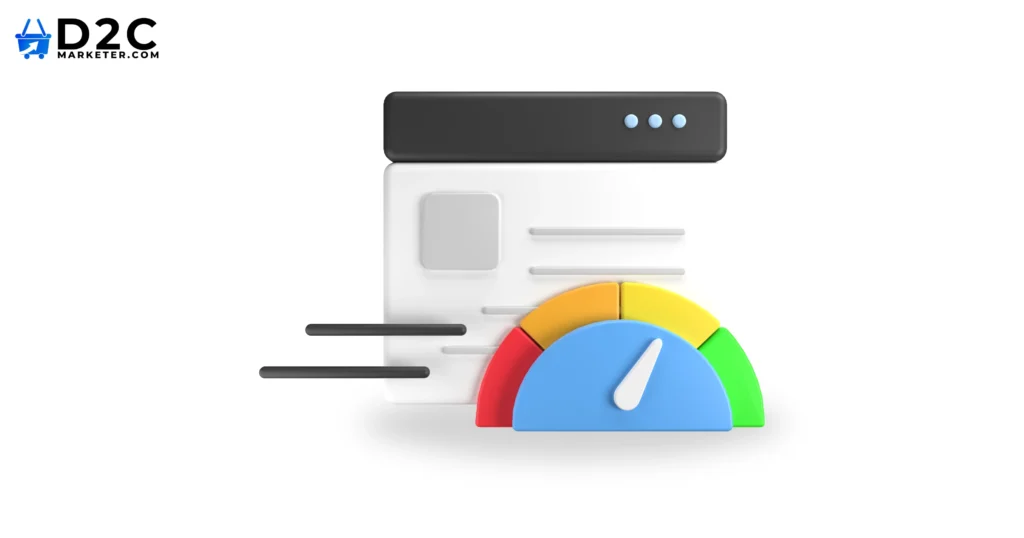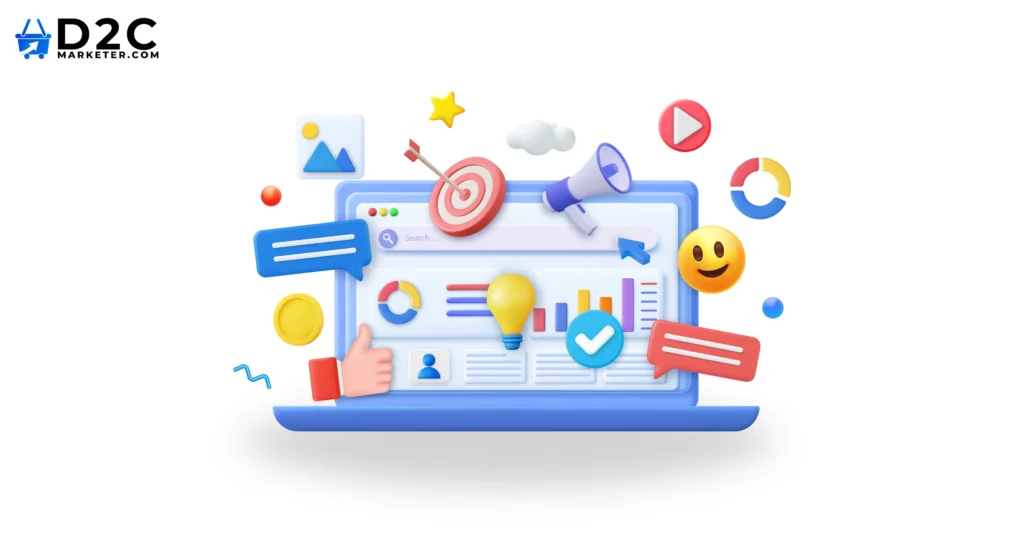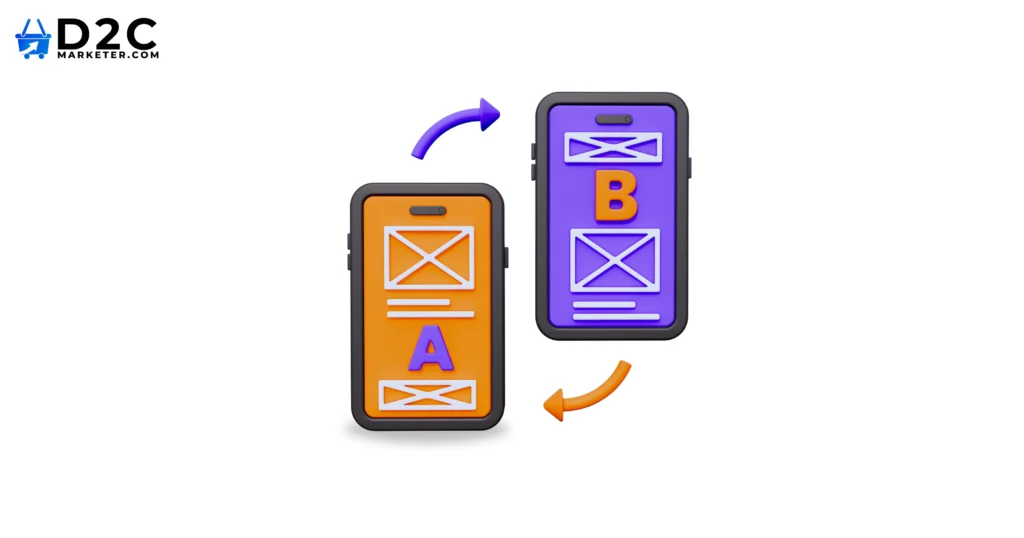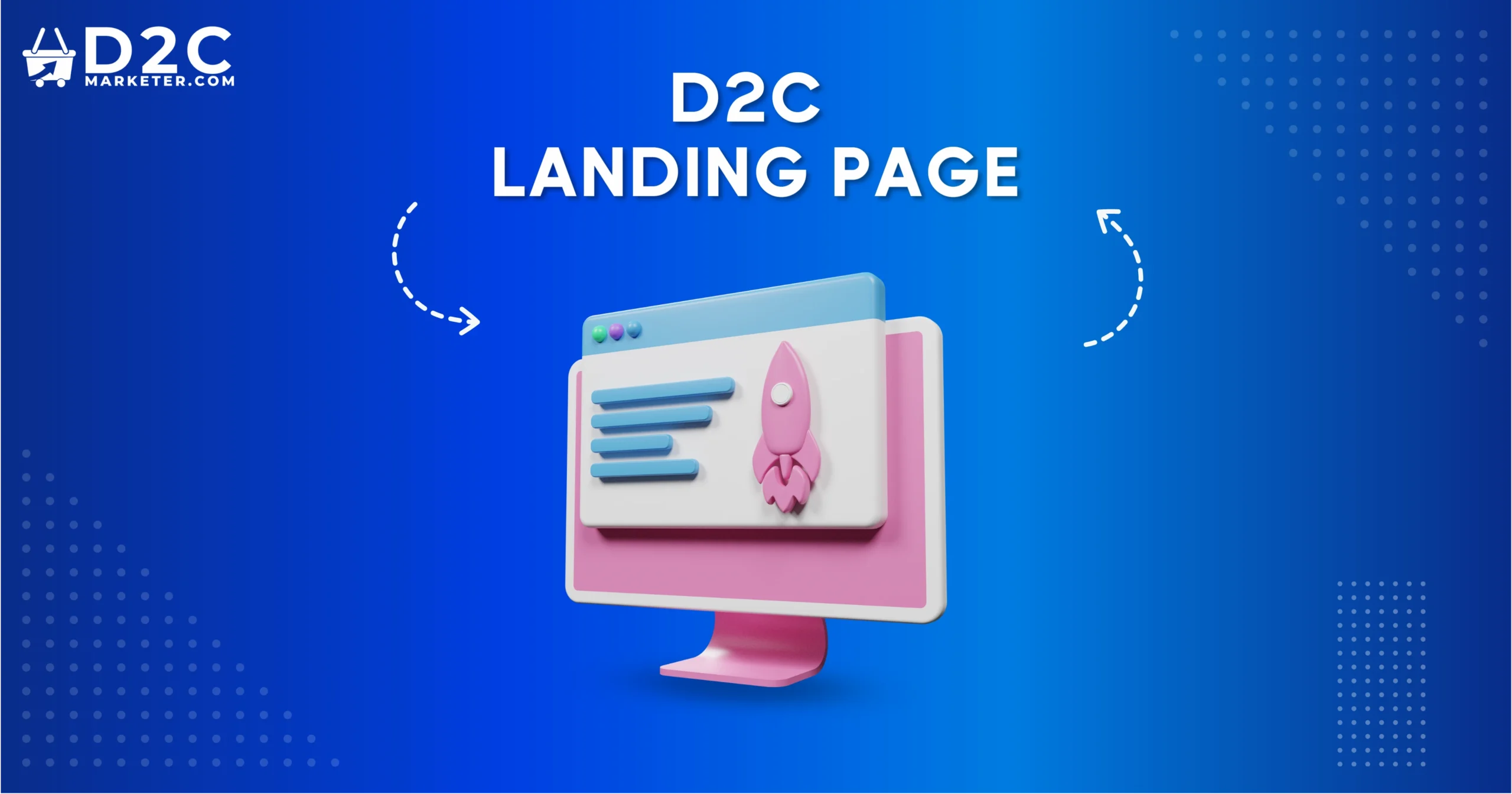How to Create High-Converting D2C Landing Pages
When it comes to growing a D2C brand, your landing page can make or break a sale. It’s the first thing your potential customers see, and it has just a few seconds to grab their attention and turn that interest into action. A high-converting D2C landing page isn’t just about looking good, it needs to be strategic, guiding visitors smoothly through the buying process.
Whether you’re looking to improve your conversion rate optimization (CRO) or simply want to create a more engaging experience, the key is in the details. From clear calls to action to relevant SEO strategies, every element should work together to make it as easy as possible for customers to say “yes.”
In this guide, we’ll break down the essential elements that help D2C brands create landing pages that not only look great but also drive real results.
Let’s dive in!
Table of Contents
The Anatomy of a High-Converting Landing Page

To create a high-converting D2C landing page, you need to combine clear messaging with design that drives action. Here are the essential components every D2C brand should focus on:
1. A Compelling Headline
Your headline is the first thing visitors see and should grab attention within seconds. Make it clear, concise, and directly aligned with your audience’s needs. A strong headline communicates your core offer and immediately explains how it benefits the customer. It’s a vital element in setting the tone for the rest of the page and increasing engagement.
2. Strong Call-to-Action (CTA)
Your CTA is the focal point of your landing page. Whether it’s “Shop Now” or “Get Started,” the CTA should stand out visually and be action-oriented. It must tell visitors exactly what to do next and make it easy for them to act. Position your CTA in a prominent spot, and don’t be afraid to use contrasting colors to make it pop. Experiment with wording to find what encourages the highest conversion rate.
3. Social Proof & Trust Signals
Social proof, such as customer testimonials, reviews, or trust badges, can significantly boost conversions. Visitors are more likely to buy from you if they see that others have had positive experiences with your brand. Showcasing ratings, case studies, or influencer endorsements also builds credibility. Adding trust signals, like secure payment options, assures visitors that their information is safe.
4. Clear Value Proposition
Your value proposition tells visitors why they should choose your product over others. This message should be front and center, addressing how your product solves a problem or improves their life. It needs to be specific and focused on the unique benefits your D2C brand offers. A compelling value proposition reduces confusion and helps visitors quickly understand why they need what you’re offering.
By combining these elements, an attention-grabbing headline, a compelling CTA, social proof, and a clear value proposition, you create a D2C landing page that not only attracts visitors but also drives conversions and supports your overall marketing strategy.
Design Best Practices for D2C Brands

When it comes to D2C landing pages, design isn’t just about looking good, it’s about creating an experience that guides your visitors effortlessly toward making a purchase. A well-designed landing page should be visually appealing, user-friendly, and optimized for both desktop and mobile.
1. Mobile Optimization is a Must
Today, more and more shoppers are browsing and purchasing directly from their phones. Your D2C landing page must be fully optimized for mobile devices to ensure a seamless experience across all screen sizes. This means your text should be easy to read, buttons should be large enough to tap, and images should scale without losing quality. Slow-loading pages or broken layouts on mobile can result in lost sales. A mobile-optimized page is not only key for user experience but also crucial for SEO trends in D2C brands, as Google increasingly prioritizes mobile-first indexing.
2. Clean, Simple Design
The design of your landing page should be clean and minimal, focusing on what matters most: converting visitors. Avoid cluttered layouts that distract users from your key message and call-to-action (CTA). Keep the copy concise and impactful, and use whitespace effectively to allow each element to breathe. A simple design lets your product or offer shine, ensuring visitors can easily navigate the page without feeling overwhelmed. This clarity plays a significant role in boosting conversions, as visitors can quickly find what they need without distractions.
3. Fast Loading Times
Speed is a critical factor in conversion rates. Studies show that if a landing page takes more than 3 seconds to load, bounce rates increase significantly. Slow pages frustrate users, and they’re more likely to leave before even seeing your offer. Optimize images, streamline your code, and use tools like content delivery networks (CDNs) to ensure fast loading times. This not only enhances user experience but also impacts your SEO, making your D2C landing page easier to find.
4. Minimize Distractions
Every element on your page should serve a purpose. Too many links, pop-ups, or unnecessary images can pull attention away from the action you want visitors to take. Focus on clear CTAs and a straightforward design that directs the user’s attention to the most important action, whether it’s completing a purchase, signing up for a newsletter, or taking advantage of an offer. Minimizing distractions helps keep the focus on conversion, leading to higher engagement and ultimately more sales.
By following these design best practices, D2C brands can create landing pages that not only look great but also perform well, driving higher conversions and supporting long-term growth.
Pros & Cons of Minimalist Design
| Pros | Cons |
| Simple design improves focus on CTAs | Too minimal might leave out key information |
| Faster load times | Can feel too sparse or generic |
| Better mobile experience | May not capture brand personality effectively |
Writing Copy That Converts

Great design gets visitors to your D2C landing page, but it’s the copy that convinces them to stay and take action. Persuasive, clear, and compelling copy is essential for guiding users toward conversion. Here are some tips for writing copy that resonates with your audience and drives results.
1. Speak Directly to Your Audience
Your landing page copy should feel like a conversation with your target customer. Start by understanding their pain points, desires, and motivations. What problem are they trying to solve, and how can your product or service help? Use language that reflects your audience’s tone and speaks to their needs. Avoid jargon and complex sentences, your goal is to make it as easy as possible for them to see why your offer is the solution they’ve been looking for.
2. Craft a Clear, Actionable CTA
Your call-to-action (CTA) is the moment of truth. If your CTA isn’t clear and compelling, you’ll miss out on conversions. Use actionable language that tells the visitor exactly what to do next. Instead of a generic “Submit,” try something more engaging like “Claim Your Discount Now” or “Start Your Free Trial Today.”
3. Highlight the Benefits, Not Just Features
When writing your copy, focus on the benefits of your product, not just the features. Customers want to know how your product will make their life easier, better, or more enjoyable. A mattress may have “memory foam technology,” but what really matters to your customer is that it helps them sleep better. Make sure your copy connects the dots between features and real-life benefits.
4. Create Urgency Without Being Pushy
To drive conversions, create a sense of urgency, whether it’s a limited-time offer, low stock, or a special bonus for signing up. Phrases like “Only 5 left in stock” or “Sale ends in 24 hours” encourage visitors to act quickly without feeling overly pressured. Just be sure the urgency feels genuine and aligns with your overall direct-to-consumer marketing strategy.
5. Use Social Proof to Reinforce Your Message
Including a short testimonial, a customer review, or a trust badge next to your copy can make a huge difference. Social proof is a powerful tool to show that others have benefited from your product. When visitors see that other customers have had a positive experience, it increases trust and makes them more likely to convert.
By focusing on clear, customer-centric copy that speaks directly to your audience’s needs and desires, and pairing it with strong, actionable CTAs, you’ll guide visitors toward taking the next step and increase D2C conversions.
A/B Testing Your Landing Pages

Even with the best design and copy, it’s essential to test your D2C landing pages to ensure they’re truly driving the results you want. A/B testing, or split testing, allows you to experiment with different versions of your landing page to find what resonates most with your audience and delivers the highest conversion rates.
1. Start with Clear Hypotheses
Before you dive into A/B testing, make sure you have a clear idea of what you want to test and why. For instance, you might hypothesize that a more prominent CTA button will lead to more clicks, or that a shorter headline will reduce bounce rates. Having a goal or hypothesis helps you focus your tests and make data-driven decisions.
2. Test Key Landing Page Elements
There are several elements on your D2C landing page that can dramatically affect conversions. Here are some common ones to test:
- Headlines: The headline is often the first thing visitors read, so it’s essential to get it right. Test variations of your headline to see which one grabs attention and clearly communicates your value proposition. Try experimenting with different wording or tone, like testing a question-based headline versus a direct statement.
- CTA Buttons: Your call-to-action (CTA) is a critical conversion element. Test variations in the wording, placement, and color of your CTA buttons. For example, try “Shop Now” versus “Buy Today” or test different button colors to see which one leads to higher click-through rates. Small changes like these can significantly impact conversions.
- Images and Visuals: Visuals play a key role in capturing attention and engaging your audience. Test different types of images, such as product-focused images versus lifestyle images, or compare hero images with videos. Visuals should resonate with your audience and complement the message you’re trying to convey.
- Forms and Layouts: If your landing page includes a form (for newsletter sign-ups or purchases), experiment with form length, fields, and the placement of your form on the page. A simple, streamlined form can often lead to more conversions than a lengthy one that feels like a barrier to entry.
3. Analyze Results and Iterate
Once your tests have run for a sufficient amount of time (usually a couple of weeks, depending on your traffic), analyze the results to determine which version of your landing page performed best. Use A/B testing tools like Google Optimize or Optimizely to track and compare metrics like conversion rates, click-through rates, and bounce rates.
Remember, A/B testing is an ongoing process. As you learn more about your audience’s preferences and behavior, you can continue refining your D2C landing page to improve conversion rates further. Testing different versions, elements, and strategies ensures your landing pages are continually optimized, helping you increase D2C conversions and stay ahead of competitors.
By making A/B testing a regular part of your D2C marketing strategy, you’ll be able to fine-tune your pages and achieve higher conversion rates, driving more sales and supporting long-term growth for your D2C brand.
How D2C Marketer Increased Conversions by 50%
The Challenge:
When one of our clients, a promising D2C brand came to us, they were struggling with a major problem: low conversion rates on their landing page. While their product was excellent and their customer base solid, the landing page just wasn’t converting visitors into customers. Visitors were dropping off before completing the purchase, leaving potential sales on the table. This is where we knew we could make an impact.
The Solution:
As an agency with expertise in conversion rate optimization (CRO), our first step was to thoroughly analyze their landing page and identify the areas that needed improvement.
- Faster Loading Times: The first issue we tackled was slow load speeds. Studies show that even a one-second delay in loading time can significantly hurt conversions. By optimizing images, improving server response time, and reducing unnecessary page elements, we sped up the landing page, keeping visitors engaged and preventing them from bouncing out due to frustration.
- Clear, Actionable CTAs: We focused on call-to-action (CTA) buttons. We made sure the CTA copy was action-oriented and crystal clear, guiding visitors seamlessly through the conversion process. Phrases like “Shop Now” or “Claim Your Offer” made it immediately clear what the visitor should do next, which boosted click-through rates.
- Enhanced Social Proof: To build trust, we added customer testimonials, reviews, and trust badges throughout the page. Social proof is a powerful tool in direct-to-consumer marketing strategies because it helps reduce buyer hesitation by showing real-world satisfaction from other customers.
The Result:
Within just three months, these changes led to a 50% increase in conversions. The improvements didn’t just increase engagement on the landing page, they aligned perfectly with the D2C brand strategy, driving more customers through the funnel and ultimately leading to a significant boost in sales. Our client’s landing page became a much more powerful asset in their D2C marketing channels, resulting in higher conversion rates and increased revenue.
Conclusion
Creating a high-converting D2C landing page isn’t just about pretty design, it’s about understanding your audience, optimizing user experience, and guiding visitors smoothly through the sales funnel. By focusing on key elements like compelling headlines, clear CTAs, social proof, and a streamlined design, D2C brands can significantly increase conversions and drive sales. With the right CRO for D2C strategies in place, your landing page can become a powerful tool for growth.
At DesignScript, we specialize in crafting landing pages that not only look great but are optimized for conversion. If you’re ready to turn your landing page into a sales machine, we’re here to help.
Need help creating high-converting landing pages?
Let DesignScript optimize your landing pages to drive more sales. Reach out today!
FAQs
A high-converting landing page has a clear and compelling value proposition, strong visuals, a persuasive call-to-action (CTA), and a seamless user experience.
Mobile optimization is crucial as a significant portion of traffic comes from mobile devices. A mobile-friendly landing page ensures a smooth user experience and higher conversion rates.
The CTA should be clear, concise, and action-oriented. It should tell the user exactly what to do next and create a sense of urgency.
The frequency of A/B testing depends on your resources and the complexity of your landing page. However, it’s generally recommended to test at least one element every few weeks or months.
The time it takes to see results from landing page optimization varies depending on factors like the size of your audience and the changes implemented. However, you should start seeing some results within a few weeks.

